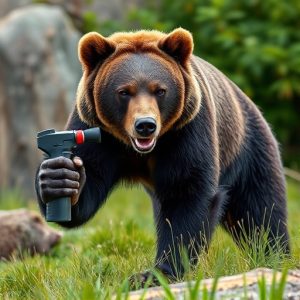Maximizing Bear Spray Safety: Testing, Guidelines, and Protection
"Bear spray, a powerful deterrent against aggressive bears, relies on capsaicin (chili pepper c…….
"Bear spray, a powerful deterrent against aggressive bears, relies on capsaicin (chili pepper compound) for pain and flight responses, with 'Maximum Strength' sprays (10%+ capsaicin) offering enhanced protection. Safe usage requires adhering to the Bear Spray Testing Safety Guidelines for product understanding, storage, disposal, and maintenance. Correct application techniques are vital; consulting experts ensures tailored advice based on bear species and regions. Rigorous testing protocols ensure spray potency, accuracy, and user safety, while training programs teach proper handling and deployment. Selection factors include capsaicin concentration, weather, range, and personal needs, with 20%+ sprays recommended for robust protection against black and grizzly bears."
“Bear spray, a powerful defense against aggressive bears, has become an essential tool for outdoor enthusiasts and essential for wilderness safety. This article delves into the intricate world of bear spray, focusing on its maximum strength capsaicin composition and how it enhances protection. We explore rigorous safety testing protocols, offering valuable guidelines for proper usage and training. Additionally, we provide insights to help users choose the right bear spray, ensuring optimal safety in bear country, adhering to essential safety guidelines.”
- Understanding Bear Spray: Composition and Effectiveness
- Maximum Strength Capsaicin: What It Means for Protection
- Safety Testing Protocols for Bear Spray
- Guidelines for Proper Usage and Training
- Choosing the Right Bear Spray: Factors to Consider for Optimal Safety
Understanding Bear Spray: Composition and Effectiveness
Bear spray, also known as bear deterrent or bear pepper spray, is a specialized protective tool designed to deter aggressive bears when faced with an encounter in their natural habitat. Understanding its composition and effectiveness is crucial for anyone venturing into bear country. The primary active ingredient in bear spray is capsaicin, a compound derived from chili peppers that stimulates pain receptors in the eyes, nose, and throat, causing the bear to flee. This potent irritant is typically suspended in a fine mist, allowing for easy application during a close encounter.
When it comes to bear spray testing safety guidelines, it’s essential to follow recommended protocols. These include conducting thorough research on the product’s label, understanding its range and effectiveness, and ensuring proper storage and disposal methods. Regular maintenance and expiration dates should be checked to guarantee optimal performance when needed. Bear spray has proven to be an effective tool in preventing attacks, but its success depends on correct usage. Always consult with experts or local authorities for specific safety measures and guidelines tailored to different bear species and regions.
Maximum Strength Capsaicin: What It Means for Protection
Maximum Strength Capsaicin refers to the highest concentration of capsaicinoids, the chemical compounds responsible for the heat and numbing sensation in chili peppers, found in bear spray. This potent ingredient significantly enhances protection against bears when used correctly. According to Bear Spray Testing Safety Guidelines, a “maximum strength” product should contain at least 10% capsaicin by weight. Such a high concentration ensures that even a small amount of spray can create an effective barrier, deterring aggressive bear encounters.
The effectiveness of bear spray relies not only on maximum strength capsaicin but also on proper application technique and understanding the product’s range. Users should familiarize themselves with recommended usage instructions, ensuring they get up close to potential threats—typically within 2-3 meters—to maximize the spray’s impact. Following Bear Spray Testing Safety Guidelines rigorously promotes safe use, minimizing risks while maximizing the protective benefits of capsaicin in bear spray.
Safety Testing Protocols for Bear Spray
Bear spray, a powerful deterrent against aggressive bears, undergoes rigorous safety testing protocols to ensure its effectiveness and user safety. These guidelines are designed to evaluate the spray’s potency, accuracy, and overall performance in simulated bear encounters. Testing involves exposing animals to controlled amounts of the spray, monitoring their reactions, and measuring the distance and duration of its active ingredients, notably capsaicin, the compound responsible for the burning sensation it causes.
Safety testing also scrutinizes the spray’s impact on non-target species and the environment, ensuring minimal harm. This process involves laboratory experiments and field trials, where researchers assess the spray’s irritancy, corrosion, and potential toxicity to humans and other animals. Adherence to these Bear Spray Testing Safety Guidelines is paramount to guarantee that products reaching consumers meet stringent standards, promoting responsible bear spray use and enhancing safety in bear country.
Guidelines for Proper Usage and Training
Using bear spray safely requires adhering to strict testing and training guidelines. Before carrying bear spray, individuals should complete a certified training program that covers proper handling, deployment techniques, and de-escalation strategies. This training ensures users understand the potential risks and consequences of using such a potent substance.
During usage, it’s crucial to follow safety protocols, including ensuring adequate distance from bears, proper aiming technique, and understanding the spray’s range and duration. Regular bear spray testing is recommended to maintain proficiency and familiarize oneself with product updates and best practices. This proactive approach maximizes safety during encounters with bears in their natural habitats.
Choosing the Right Bear Spray: Factors to Consider for Optimal Safety
Choosing the right bear spray is crucial for ensuring optimal safety in potential encounters with bears. Several factors come into play when selecting a bear spray, each playing a vital role in its effectiveness and your overall protection. One of the key considerations is the concentration or strength of capsaicin, the active ingredient responsible for numbing and deterring bears. Maximum strength bear sprays, typically containing 20% capsaicin or higher, offer stronger protection against both black and grizzly bears. However, it’s important to note that higher concentrations don’t always equate to better performance; factors like weather conditions, spray pattern, and distance can impact the spray’s effectiveness.
When evaluating bear spray options, pay close attention to testing safety guidelines. Reputable manufacturers often conduct rigorous testing to ensure their products meet specific criteria for spray distribution, concentration, and durability. Look for sprays that have been independently tested by recognized organizations, as this guarantees a certain level of quality and performance. Additionally, consider factors such as the spray’s range, ease of use, and any additional features like a built-in holster or alarm system. Choosing a bear spray that aligns with your specific needs and adheres to safety guidelines is essential for a safe and successful encounter with these magnificent creatures.
Bear spray, specifically those containing maximum strength capsaicin, offers a powerful defense against bear encounters. Understanding the composition and safety guidelines is paramount for effective protection. Rigorous testing protocols ensure product quality and reliability. By following proper usage training and choosing the right bear spray with consideration for factors like can size and spray pattern, individuals can enhance their safety in bear country. Adhering to these safety guidelines enables outdoor enthusiasts to enjoy nature while minimizing risks associated with bears.


